| Article ID | Journal | Published Year | Pages | File Type |
|---|---|---|---|---|
| 4050644 | Clinical Biomechanics | 2012 | 6 Pages |
BackgroundGait analysis is an important instrument in clinical research and results should be objective. The purpose of this study was to quantify clinical outcomes of two biomechanical models with different anatomical coordinate systems and angle decomposition strategies for knee joint kinematics.MethodsThe study was designed to compare a functional approach and a predictive approach with a single comprehensive marker set. 10 healthy subjects and 12 subjects with knee osteoarthritis were analysed. Distinctive gait variables were averaged across five trials. Agreement between methods was illustrated with the so-called levels of agreement. Differences between models were quantified using a paired t-test or Wilcoxon-Signed Rank test in case of non-normality (Shapiro–Wilk test). Unpaired t-tests/Wilcoxon tests were used to compare gait variables between healthy subjects and subjects with knee osteoarthritis, and to examine whether statistical analysis of this comparison would yield different data interpretations when using different models.FindingsOutcome variables differed between the functional and predictive approaches in the sagittal plane (0.1–3.1°), and transverse plane (1.0–3.7°). With respect to the range of motion in the given movement plane, variables in the sagittal plane of the knee were more consistent between methods. The functional approach was more sensitive for detecting differences between groups for sagittal plane kinematics. Statistical analysis for transverse plane kinematics differed substantially between models.InterpretationSensitivity to detect differences of kinematic data between population groups can vary between biomechanical models. Rotational gait variables are inconsistent between models and should not be used as clinical outcome variables in daily routine.
